本文由 José Adrião Arquitetos 授权mooool发表,欢迎转发,禁止以mooool编辑版本转载。
Thanks José Adrião Arquitetos for authorizing the publication of the project on mooool, Text description provided by José Adrião Arquitetos.
José Adrião Arquitetos:在20世纪中期以前,该项目基地一直是里斯本西北部的Benfica地区的一片农业用地,当地的Ribeira de Alcântara水域保障了该地块肥沃的土壤,丰富的水资源形成的溪流和泉涌成为了这里的特色地标,Fonte Nova(意为“新喷泉”)也就成了该地的代名词。直到里斯本城市结构中的一条重要道路Estrada de Benfica贯穿了整个项目场地,60年代修建的辐射状城市道路(2a环形),把项目基地分成了两半,这一情况对当地造成了极大的影响:农田被破坏,城市道路被阻断。
José Adrião Arquitetos:Till mid of the 20th century, the site area was a farming territory in Benfica, northwest Lisbon. A water stream (Ribeira de Alcântara) provided plenty water to assure fertile lands. Water streams and fountains were a landmark. Fonte Nova (in eng. New Fountain) became the popular name from witch the area was known. The site was crossed by an important road in Lisbon’s urban fabric: Estrada de Benfica. In the sixties, the radial city road (2a Circular) was built. A flyover of 2ª Circular divided the site in half. This condition had a big impact in the area: the farms were destroyed and the continuity of local roads and pathways was broken. Over the years, the site became a parking lot, and end up using all the space available.


近50年来,大量车辆停靠在项目场地上,这里几乎完全变成了一个停车场,而种在车辆间70余棵tipuana-tipu树,形成了一片独特的树冠层。2015年里斯本市政厅发布了一项名为“Uma Praça em cada Bairro(一街一广场)”的城市发展总体规划,旨在提升城市周边广场。
For 50 years, the massive presence of parked cars was the main site feature. Between parked cars, 70 tipuana-tipu trees were planted and grew up creating a special canopy. In 2015, Lisbon City Hall, released an urban development master plan to improve the city neighborhood’s squares: “Uma Praça em cada Bairro”.
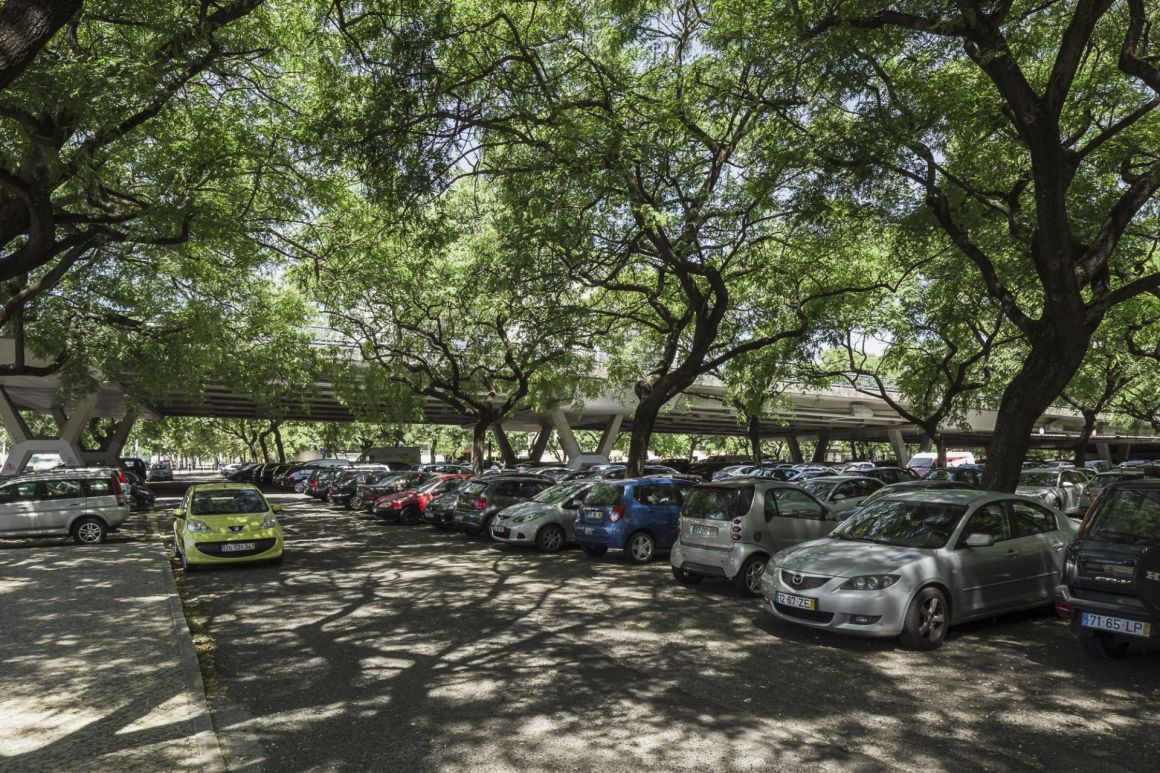
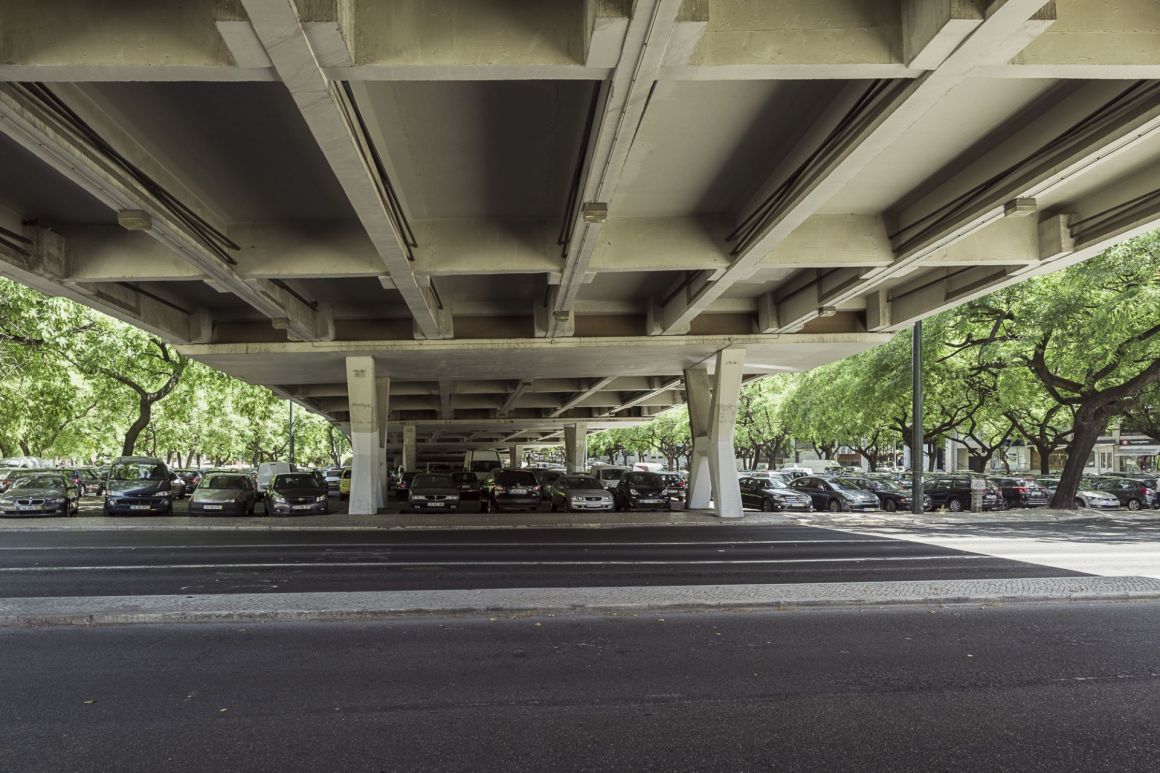
改造的目的 Aim of the Intervention
该项目改造面积为3.5公顷,设计策略是扩展铺装系统,来重建在停车场与立交桥建成后所失去的连接性,这样可以减少50%的停车用地,有利于低速交通和创造休闲空间。该项目旨在创造一个丰富多样、包容亲和的环境,吸引不同年龄层的人使用。场地的公共空间使用空间可以是活跃的,也可以是安静的,无论怎样都应是大家能够轻松参与进来的。
The project area was 3,5 hectares and the strategy was to define an extended paved area that aimed to re-establish the connections lost when the parking lot and flyover was built. This operation was an opportunity to reduce in 50% the parking lot area in favor of soft mobility and leisure spaces. The project aimed to be attractive to people from all ages, to be inclusive, friendly and casual. The use of space can be active or contemplative. The public space should be easily understood by all.
▼结合旧城市结构的设计提案 Overlay of the proposal with the old urban fabric

▼总平图 Site Plan

广场设计利用了现有的树木- tipuana-tipu。保留了这片树林,并给予足够的生长空间。树投下的阴影和空地成为了这里重要的场地特征。
The square design takes advantage of the existing trees – tipuana-tipu. The forest was conserved, keeping all the specimens, giving them room to grow. The tree’s shadows and clearings became an important site feature.

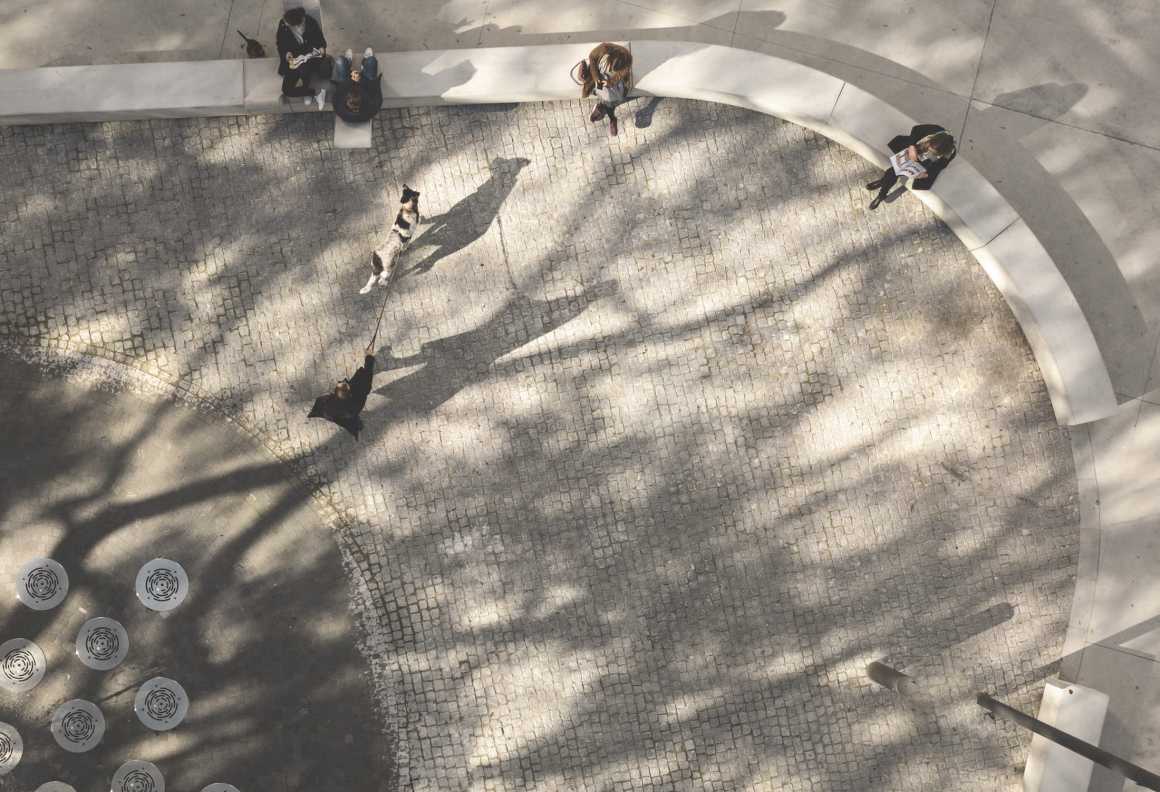
“岛屿”形式的休闲空间在特定的位置插入混凝土铺装的人行道。每一个“岛屿”内部,都是不同的活动空间,包括亭子、露台、喷泉、遛狗公园、操场和三个花园空间。
The pavement is in concrete, in specific locations it’s punctuated by leisure spaces in the form of “islands”. Inside each of these “islands” different activities take place. There are kiosks and terraces, a fountain, a dog park, a playground and three garden areas.
▼岛屿-南报亭及Tipuanas-tipu树 Island- south kiosk and Tipuanas-tipu trees
▼岛屿-东花园及2º环形立交 Island- east garden and 2ºCircular flyover

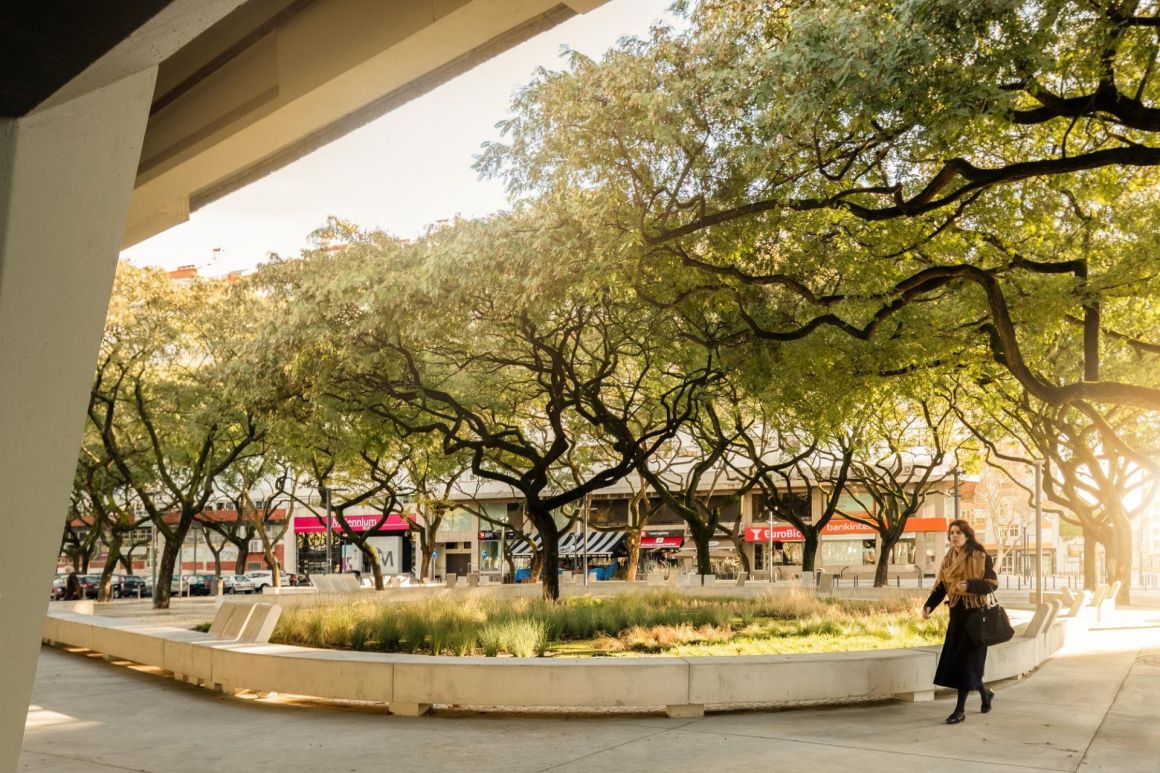

▼岛屿-西花园及2º环形立交 Island- west garden and 2ºCircular flyover


▼岛屿- 犬类公园 Island- dog park

植物设计参照场地原始的植物群落,精心选择的植物种类在作为污染过滤器的同时,也不断吸引着人们聚集过来。喷泉的喷水声掩盖了汽车的交通噪音,其水雾也使得空气更加清新。
A careful selection of riparian species was planted, referring to the of the original area flora, acting as a pollution filter and an attraction for people to gather around. The fountain water jets sound mask the car traffic noise and fresh up the air.
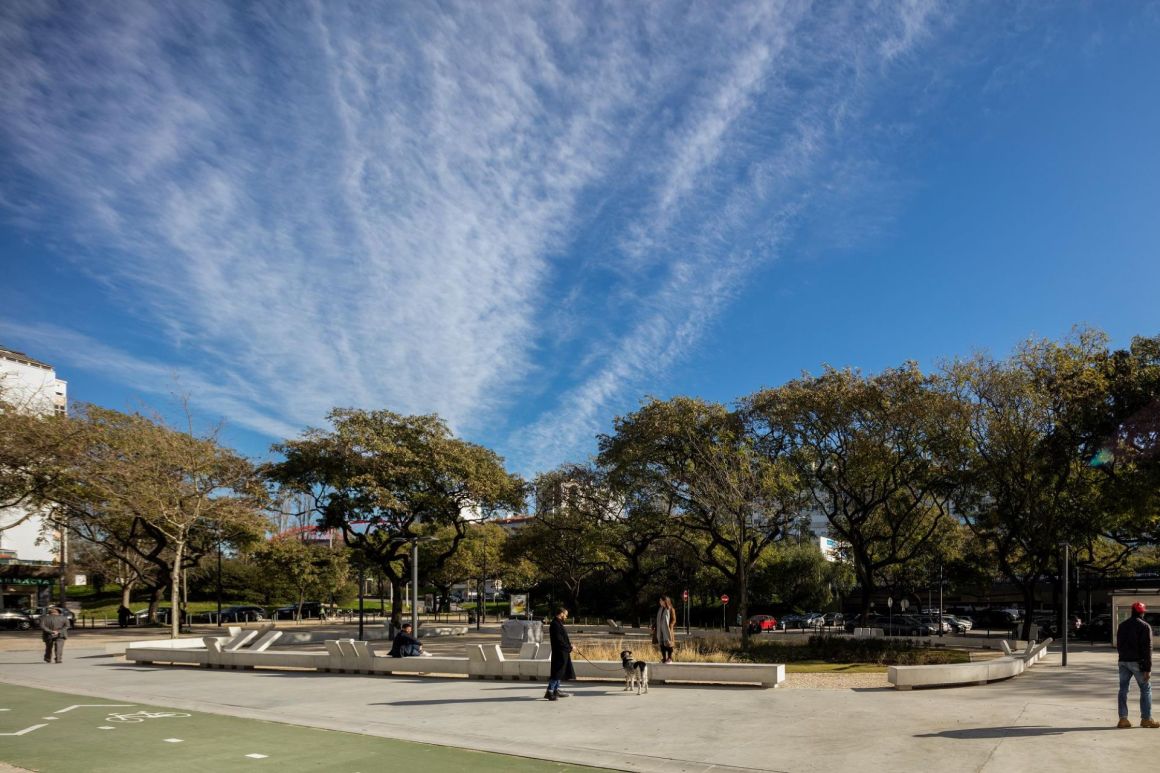
▼岛屿-喷泉 Island- fountain
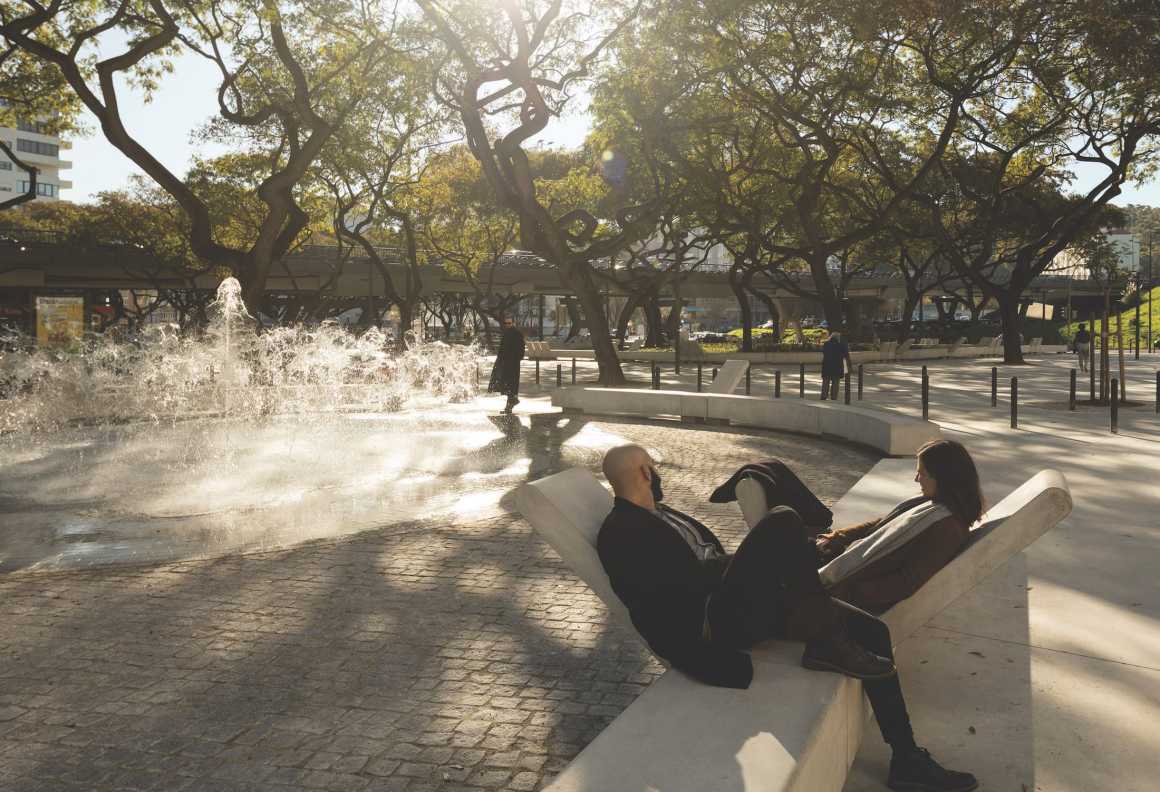

混凝土长凳围成了岛屿的边界,共有四种长凳类型:长直椅、曲形椅和两种不同靠背角度的独立座椅。这些不同形式的长凳组合可以创造多样性,这样,无论是个人还是团队集体,都可以以多种方式使用它。
The islands forms are limited by concrete bench boundaries. There are 4 bench types: straight, curve and 2 types of individual seats with different back angles. This modules are place to create diversity so that people, alone or in group, can use it in multiple ways.

立交桥下区域设置了夜间照明,不受日晒雨淋,可以全天进行多种活动。
The area covered by flyover is lit during the night allowing 24 hours of multiple activities, protected by the sun and by the rain.
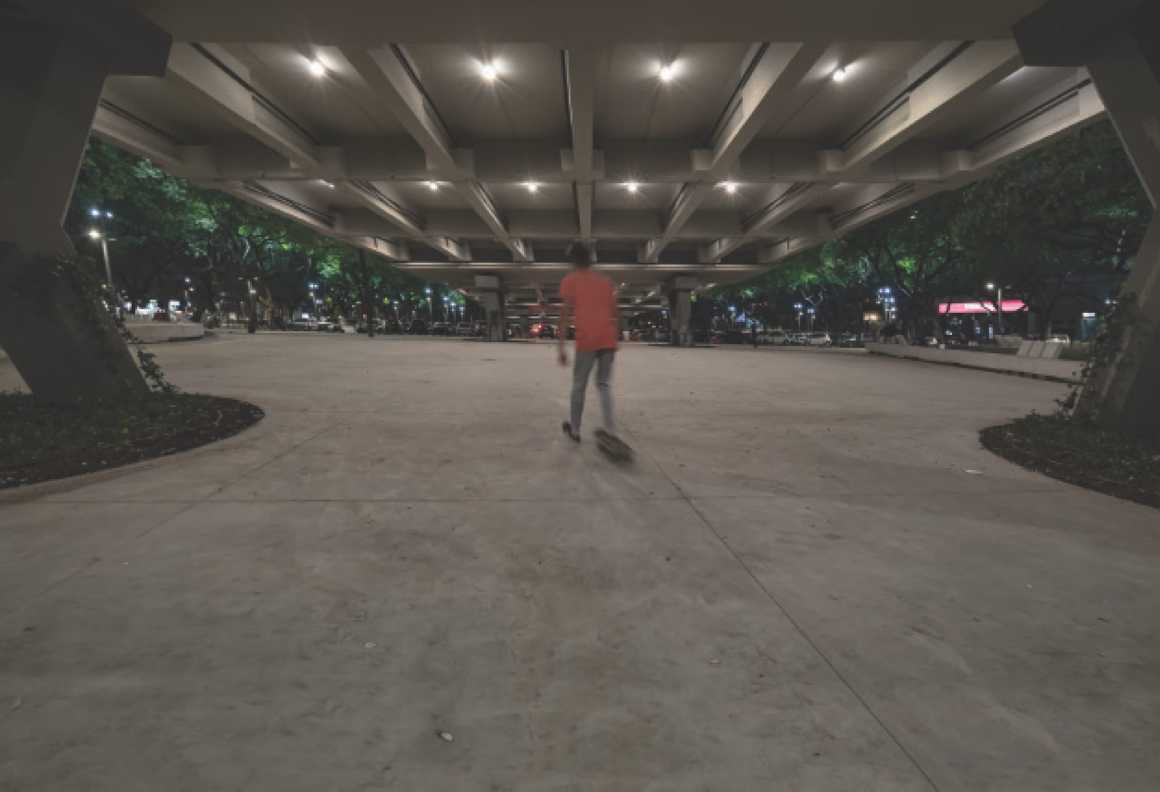
该项目选择的是在里斯本的公共空间常见的材料,这种材料耐腐蚀,易于维护,就如流行的“vidraco”石或花岗岩一样适用于各种活动空间。有许多案例表明,我们可以清理和再利用现场发现的人行道,比如这里的一个“岛屿”,就完全再利用了这个60年代设计的人行道。道路车道也进行了改造:将车道宽度降低,从而达到降低车行速度的目的,公交车道也进行了优化设计,为了提高行人的安全性和舒适度, 也使得特殊交通工具的使用变得更加便捷,我们加宽了人行道。广场的自行车道与里斯本的自行车道网络相连, 自行车道上安装了新的LED路灯系统,暖色调的灯光洒向地面,冷色调的灯光照向树冠。
The materials are resistant and easy to maintain. The choice was to use materials common in Lisbon’s public spaces like the popular “vidraço” stone or granite suitable for each activity. In many cases it was possible to clean and reuse pavements found onsite like, in one “island”, where a pavement with a sixties design was totally reused. The road lanes were modified: the car lanes widths were reduced to lower car speed and the bus lanes were planned for better performance. The sidewalks width increased for pedestrian safety and comfort and suitable for special mobility needs. A bike lane was implemented connected to Lisbon’s bike lane network. For night use of the public space, it was installed a new system of LED street lights. A warm tone color light faces the ground and a cooler tone light faces the tree’s crowns.

由于干预区范围较大,施工过程分阶段进行,这样一方面可以减少对用户日常生活的影响;另一方面,也可以让用户逐渐了解并使用翻新后的空间。人行路网远离了车行路网,使人们的日常通行更加流畅安全。
Because of the intervention area with a large extension, the construction works were made by phases. This strategy allowed, on one hand, to decrease the impact of the works in the user’s daily lives; on the other hand, it was possible for the users to gradually get to know the renovated space and use it. Pedestrian circulation became more fluid and safe, protected and away from the car circulation.

当人们聚集在“岛屿”周围,坐在长椅上,这些“岛屿”在视觉上就会形成很有趣的现象。根据不同的天气情况,人们无论是独自一人还是集体一起,都会寻找阴凉或阳光充足的地方坐下。当一个人的时候,人们更倾向于坐在树下阅读或放松,而当一群人在一起时,人们则更倾向于放松随意的坐下来面对面交谈。
People gather around the “islands”, sitting on the benches. The “islands” are perceived as visually interesting. Depending on the weather, people, alone or in groups, look for shaded or sunny areas to sit. When alone, people tend to read, or relax under the trees. When in a group people tend to sit in informal ways, facing each other’s to talk.

围绕“岛屿”区域的长椅、操场、宠物公园和咖啡露台成为了聚集场所。新的路灯系统,尤其是立交桥区域的,提高了人们的安全感,越来越多的各个年龄段的用户选择在晚上使用这个空间。该地在改造之前,缺乏公共社会互动空间,而现在的Praça Fonte Nova正在逐渐成为这样的公共空间,一个适用于所有人、自由安全的、充满社区感的地方。
The benches around the “island” areas, the playground, dog park, and the coffee terraces on the area became gathering spots. The new street light system, especially in the flyover area, improved a sense of safety and more and more users from all ages use the space at evening and night times. Before the intervention, the neighbourhood lacked a space of public social interaction. Praça Fonte Nova is gradually becoming that space. A space that welcomes all, a place of freedom and safety, where a sense of community takes place.
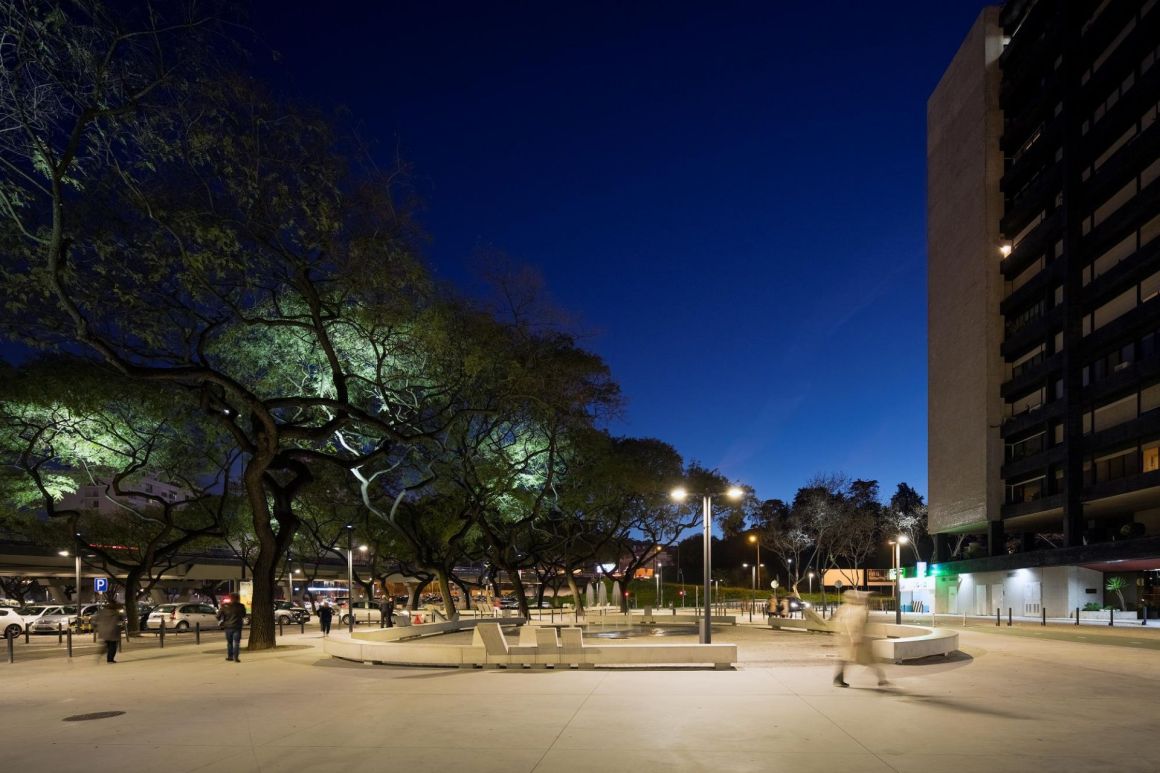
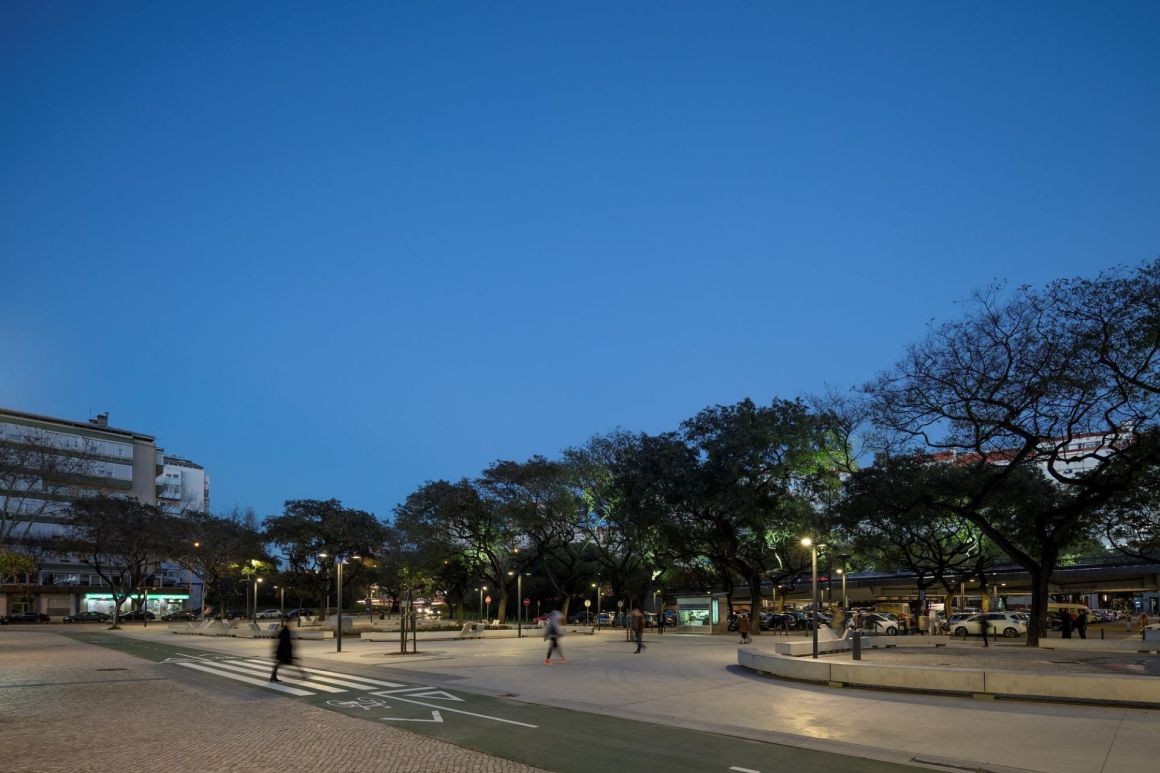
项目名称:新喷泉广场
设计年份:2015年
竣工年份:2017年
设计:José Adrião Arquitetos
建筑负责人:jose adriao
设计团队:João Albuquerque Matos – Project Manager
Ana Grácio, Ana Santos, Carla Gonçalves, Carolina Calmon, Gonçalo Ponces, Margarida Farinha, Ricardo Aboim Inglez, Tiago Mota, Tomás Forjaz
项目地点:葡萄牙 里斯本
建筑面积(m2):3.5公顷- 35000.00平方米
造价:3200000欧元
客户:CML – 里斯本市政厅
图片来源:
原场地摄影:Hungo Santos Silva
完成后摄影:FG+ SG Últimas reportagens, Fernando Guerra, Nuno Almendra
Project name: Praça Fonte Nova
Design year: 2015
Completion Year: 2017
Design: José Adrião Arquitetos
Responsible architect: José Adrião
Design Team: João Albuquerque Matos – Project Manager
Ana Grácio, Ana Santos, Carla Gonçalves, Carolina Calmon, Gonçalo Ponces, Margarida Farinha, Ricardo Aboim Inglez, Tiago Mota, Tomás Forjaz
Project location: Benfica, São Domingos de Benfica, Alameda Manuel Ricardo Espírito Santo, Lisbon, Portugal
Gross Floor Area (m2): 3,5 hectares – 35000.00m²
Cost: 3 200 000,00 €
Client: CML – Camâra Municipal de Lisboa
Photo credits:
Photography Existing: Hungo Santos Silva
Photography Completed: FG+ SG Últimas reportagens, Fernando Guerra, Nuno Almendra
更多 Read more about:José Adrião Arquitetos


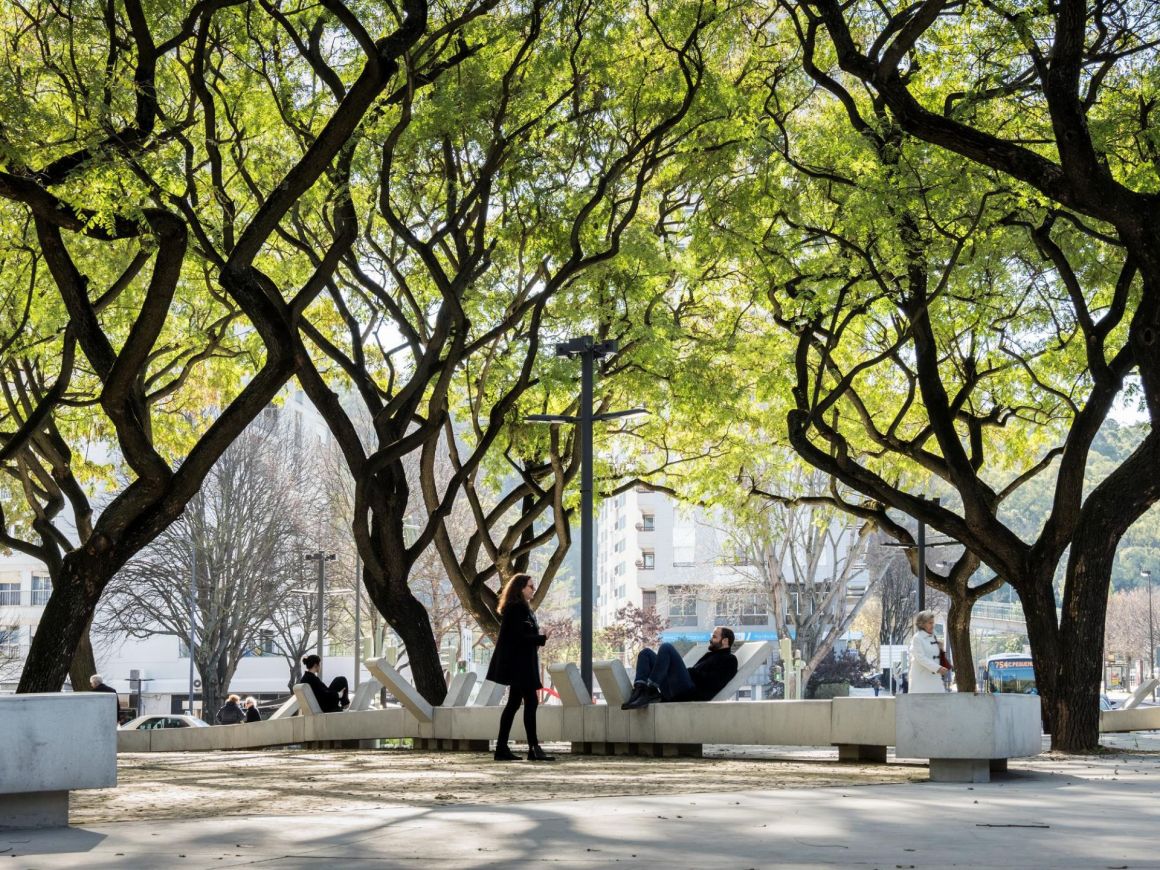
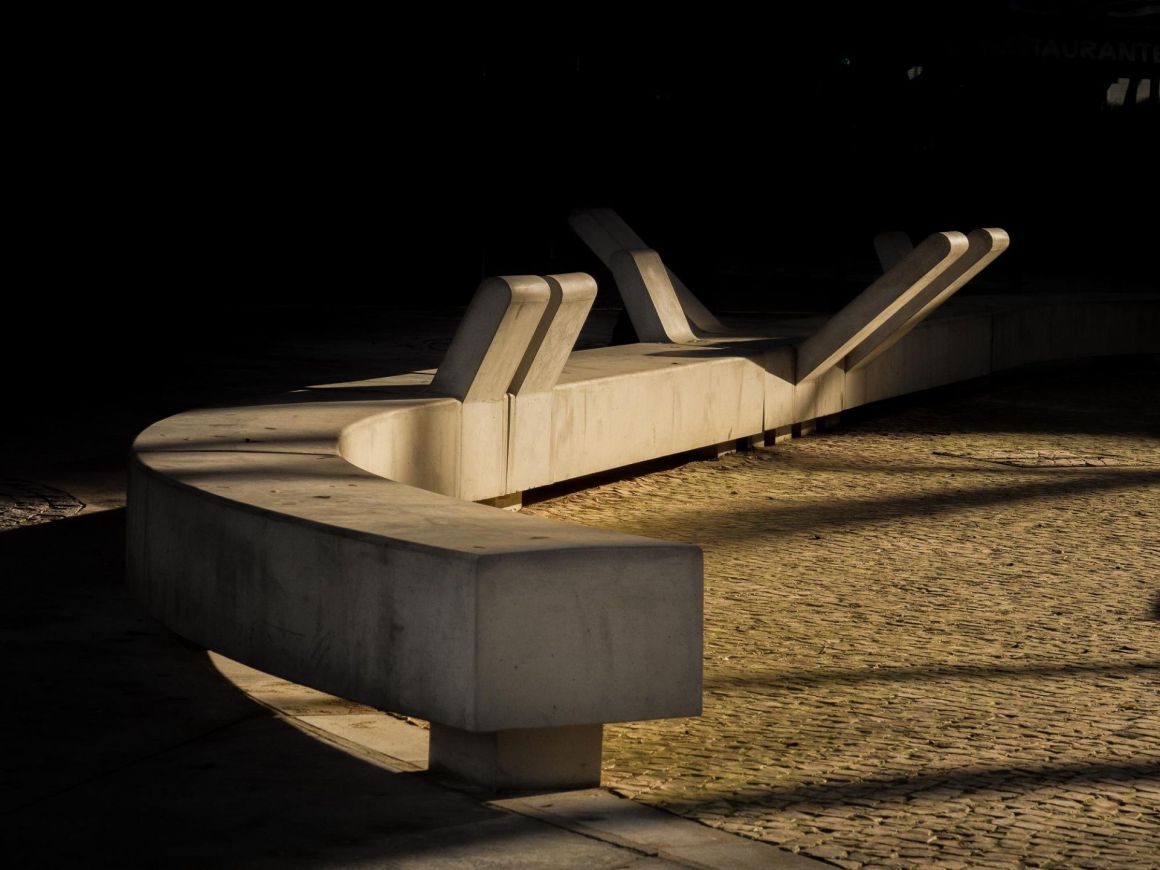
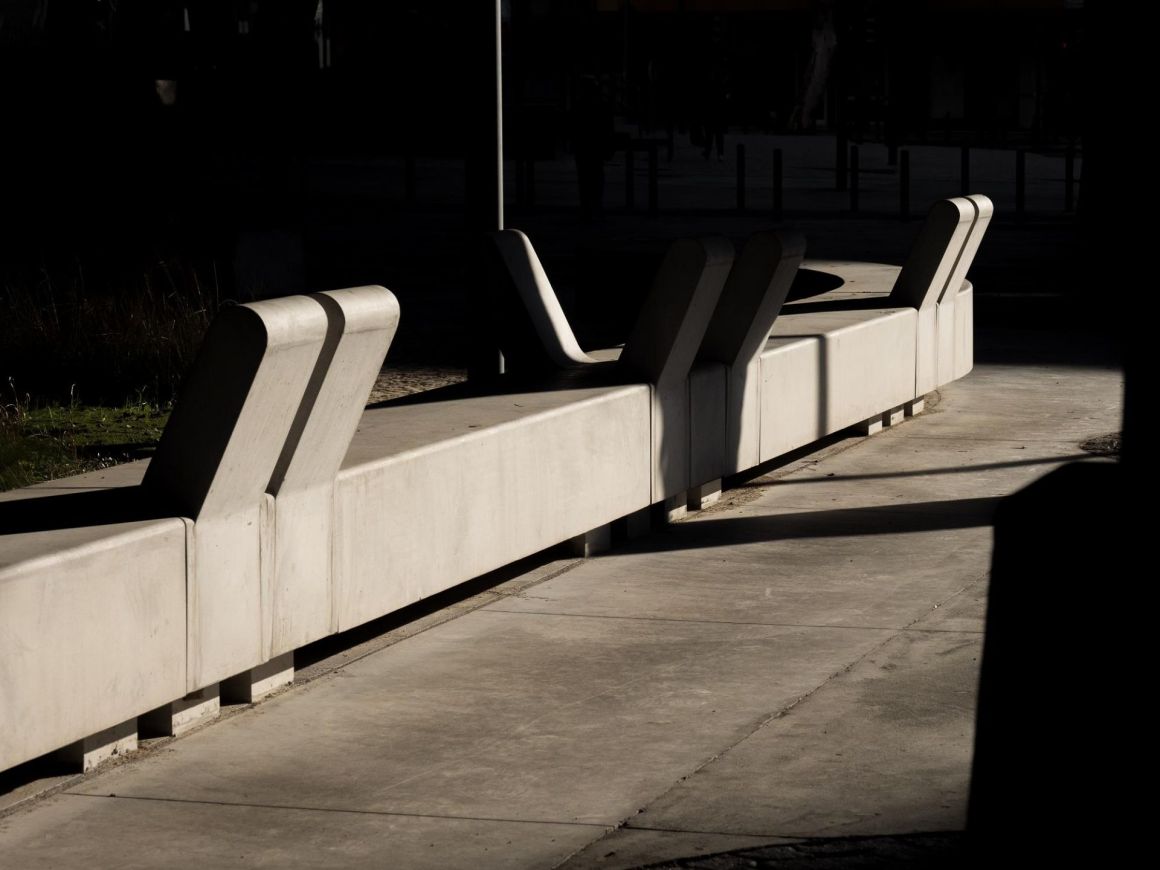


嗬,这些树长得真棒,每棵都有个性,形成的整体空间感也极好~~椅子靠背正反设置也很人性化~~